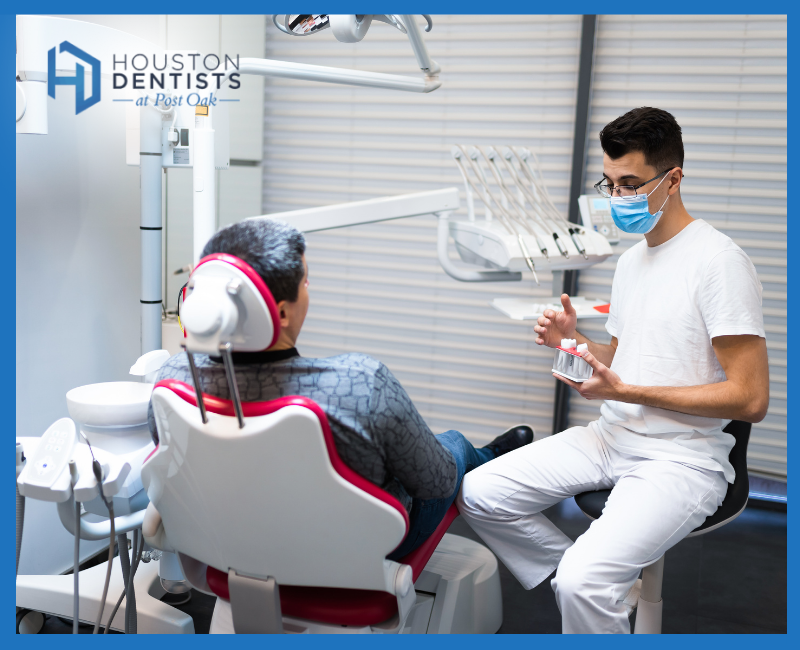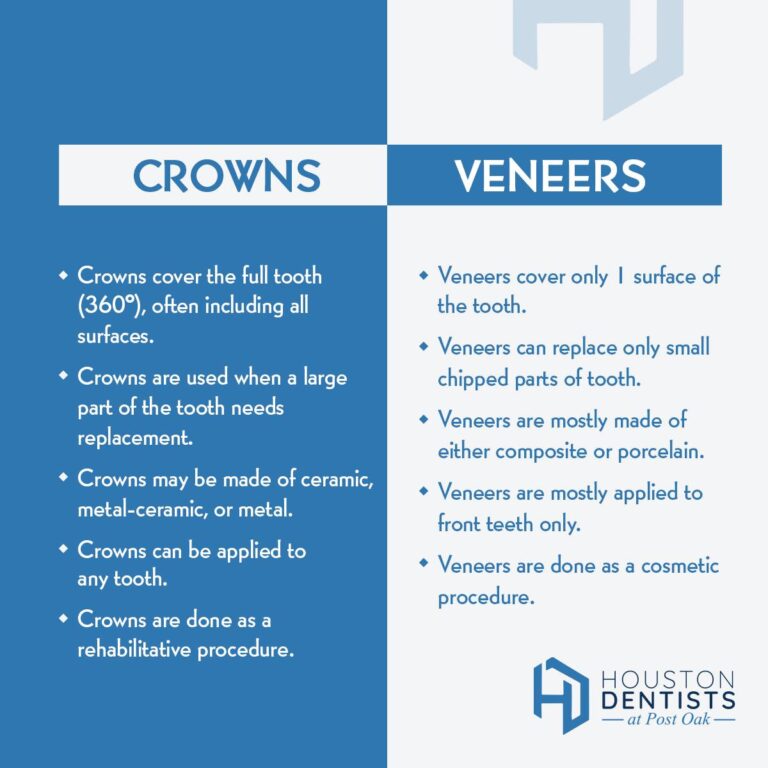Veneers are a game-changer for achieving a radiant, confident smile, offering a quick and effective solution for stained, chipped, or misaligned teeth. With proper care, veneers can last…

Implants, dentures, aligners, braces, bonds, veneers — dental procedures and language can be endless, confusing, and overwhelming! Fortunately, information is available, like this overview of dental crowns! And even better than that — there are caring dental experts at Houston Dentists at Post Oak to answer any questions and help you understand the dental world and what they can do for you!
Dental Crown: Types, Cost, and Procedure
A dental crown is a type of cap placed on top of a damaged tooth. Dentists recommend dental crowns when:
- Your tooth has a very large filling that is bigger than your natural tooth structure.
- Your tooth had root canal therapy.
- You have a combination of root canal therapy and a large filling.
- You need a crown for cosmetic reasons.
This article will discuss dental crowns, how a dentist decides you need one, and alternatives to getting a dental crown.
Types of Dental Crowns
Dental crowns can be made using different types of materials. Among them are:
- Gold and other metal
- Porcelain (ceramic) or glass ceramic
- Porcelain fused to metal (PFM)
- Zirconia
- Lithium disilicate
These materials are used to make crowns for different purposes. For example, a survey of 1,777 dentists found more than half preferred lithium disilicate for anterior crowns (front position) while they were more evenly split between all-zirconia crowns, PFM, and the lithium disilicate for posterior (back position) crowns. Other findings were:1
- PFM and metal were preferred in offices treating more people with insurance coverage.
- Busy practices also chose PFM, likely because of faster and easier procedures.
- All-zirconia use was more common in rural offices.
- Rising cost for metals often makes other options more attractive.
- Resins might be used to make a temporary crown.
Other considerations can include newer technologies, like 3D-printed crowns.
Who Needs a Crown?
Dental crowns are manufactured for a specific tooth placement, whether it’s an existing or artificial tooth. People who use dental crowns may do so because the crowns:
- Cover (cap) a damaged or unattractive tooth
- Fill a space between missing teeth, as part of an implant
- Support an artificial tooth from either side, as part of a dental bridge
Sometimes, a dental crown can be used to create a protective shell around a tooth that’s been weakened by other treatments, like a root canal.
Cost of Dental Crowns
The cost of a dental crown is subject to a host of factors, ranging from the purpose of the crown (e.g., as part of a single implant or a bridge) to the materials and methods used to manufacture it (for example, less costly all-zirconia crowns or resins used in 3D-printed crowns).
A crown meant to provide a single-tooth implant may use fewer materials but result in more frequent office visits. Or, a three-unit crown that’s part of a bridge may seem a more durable repair but it also is likely to cause permanent damage to the two adjacent teeth.
Costs also vary depending on your provider, geographic location, laboratory fees, and insurance coverage. The average cost is typically between $1,000 and $3,500. You can expect a crown to last about 10 to 15 years, depending on the type and materials used.
Dental Crowns and Different Circumstances
Not all crowns are suitable in all situations. For example, certain types of endocrowns (lithium disilicate among them) are considered a reliable alternative for molars but, as of yet, not for other teeth. Or, certain PFM crowns could interfere with proton beam treatments in head and neck cancer. Your crown (and costs) will therefore depend on your specific circumstances.
Procedure for Dental Crowns
The way in which a dental crown is placed will depend on factors that include the type of crown and where it’s going to be inserted. There also are preparations that need to be made in both the crown materials and your teeth before the crown is placed.
These steps and factors include:
- Dental impressions, either through digital scans or traditional physical molds to provide the exact shape of your teeth to the lab
- Shading to match tooth color, especially with ceramic and PFM crowns (but not gold crowns)
- Preparing the tooth, such as removing old decay, filling the tooth, and placing a rubber cap
- Shaping the tooth, to ensure the crown will be a precise fit at all the edges
Same Day Service
With advanced technology, same-day visits can result in quickly prepared teeth and digital impressions that have your crown produced and ready to place immediately. No temporary crowns are needed. The easier and more convenient process is typically more expensive.
First Visit
With a more traditional process, your first visit will involve X-rays to check the tooth where you need the crown and the bone that’s around it. This is to identify any other treatments that may need to be made first, or whether there’s a higher risk of infection or complication.
The dentist will use a local anesthetic to numb the tooth and surrounding tissues. If you’ve had a root canal, your dentist will still likely choose to use anesthetic because of how close to the gum and tooth tissue they will be working. They then reshape the tooth to a precise fit for the crown.
The type of crown being used will determine how much of your tooth will be reshaped or removed. They also may need to make repairs, like fillings, at this point, before making the final digital or dental mold impressions.
It’s at the first visit you’ll receive a temporary crown until the dental crown is ready. These can be made quickly using 3D-printing technology.2 They’re needed to protect the tooth because most of the enamel is removed from the tooth during the preparation stage, leaving exposed dentin. The temporary crown stays in place until the permanent crown is ready.
With traditional molds, a final impression takes between three and five minutes to fully set. The dental team will inspect the impression for any air bubbles or spaces. It may be necessary to repeat the impression several times to obtain an accurate impression.
Second Visit
It can take a few weeks for a dental lab to produce your crown, which will be placed at the second visit. The dentist will remove the temporary crown and prepare the fit for your permanent crown. They’ll then numb the tooth and cement the new crown into place.
Using a piece of dental floss, your dentist will also check the contacts between the crown and nearby teeth to ensure there is an ideal contact between the teeth. Contacts that are too tight or no contact at all pose a problem in the long run, when flossing or by allowing food particles to be trapped between teeth.
Your dentist will then place a bonding material onto the prepared tooth. Some bonding agents require a curing light to set the material. Once ready, the crown is placed and checked. Your dentist will wait approximately 10 minutes for the permanent cement to set. When ready, your dentist will then check how your teeth bite together.
Any high spots on the crown will be reduced on the opposing tooth. It is very important to have the bite correct. This is because a high bite can lead to tooth sensitivity and tooth pain.
If the contact is too tight, your dentist will reduce a small amount from the nearby tooth, not the crown. In cases where there is no contact, it may be necessary for the crown to be sent back to the laboratory to be remade.
Caring for a Dental Crown
After 24 to 48 hours of avoiding sticky or hard foods, you’re ready to adjust to your new crown. It is made to withstand the normal forces of biting, chewing, and grinding.
However, it is very important to understand that crowns are not indestructible. What you eat is the biggest change you will make due to your new crown. For example, candy and whole nuts (as opposed to slivers) are very destructive to crowns; you should try to avoid them.
It is also extremely important that you continue following a strict oral hygiene regimen that includes brushing, flossing, and professional cleanings for your crowns.
If, after a few days, you notice anything unusual with your new dental crown, call your dentist immediately to have the crown examined.
Common Problems That May Occur
Most crowns work well, with some small variations depending on the materials used to make them. Still, more than 10% of crowns have to be replaced within the first 10 years because of technical or physical reasons. The common reasons include:
- Crown fracture or loose placement screws
- Cementing failure
- Chipping, especially with veneered zirconia materials and bridge units
- Discoloration of tissue near the crown
When living with a dental crown, there is little you can do to prevent a placement screw that fails or the eventual fatigue of resin cement that no longer holds your crown in place. Keep in mind that dental crown failure also may depend on location; crowns for your top teeth are more at risk than those in your lower jaw because of the more complicated placement.
How well a dental crown performs will depend on your initial choices about crown materials and procedures, so discuss your options with your dentist before placement. If you do experience later complications, let your dentist know right away.
Houston Dentists at Post Oak want patients to enjoy their entire experience. Going to the dentist can be something you look forward to! Nicholas Pigneri DDS and the rest of our team are ready to help you achieve the smile you want. Visit us and discover why patients choose Houston Dentists at Post Oak for their general and cosmetic dental needs. Call 713.255.1029, follow us on Instagram or learn more here.
Reference: [https://www.verywellhealth.com/getting-a-dental-crown-1059036]






